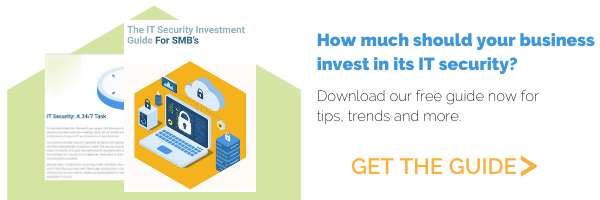5 IT Infrastructure Requirements for Small Businesses

Your IT infrastructure is the foundation your business needs to thrive and grow. Establish a good platform and you’ll be able to focus on the big picture without worrying about a lack of storage or outdated equipment.

These are the five most important IT infrastructure requirements for small businesses.
- The Right Equipment
- Seamless Integrations to Improve Productivity
- Effective Storage and Disaster Recovery
- Powerful Communications Tools
- A Robust Security Network
1. The Right Equipment
Global IT hardware spending has steadily risen for the last seven years. Even though much of today’s focus is on software and cloud-based solutions, there’s still a clear need for effective hardware.
Consider the equipment currently in use at your business. Do the computers, servers and Wi-Fi signal boosters help productivity or hinder it? There’s no need to upgrade equipment every six months but if a desktop or server begins to require a lot of time and attention, then you’re ready for a refresh.
When shopping around for new equipment, you might find yourself bombarded with pitches and price cuts that encourage you to invest in hardware that’s not right for your business. Before any large-scale investment, discuss your specific situation with experts today who can find the right solution for you.
2. Seamless Integrations to Improve Productivity
It’s your responsibility to create a working environment that breeds success. For staff to be as productive and efficient as possible, they need to work seamlessly. This means removing any obstacles and bottlenecks that are currently in their path.
By investing in systems and software that allow for easy integrations, their working process is much faster and more straightforward. There’s no awkwardness as they switch between platforms. They can access everything they need at the click of a button. It’s important that you have the solutions and applications in place to allow for staff to be able to collaborate with each other, whether they’re in the office, on the go or working from home.
If your CRM, social media, contacts database, file sharing and email marketing tools don’t work well with each other, then staff grow frustrated and productivity drops. Embrace integrations and give staff the freedom they need to thrive.
3. Effective Storage and Disaster Recovery
A survey found that 75% of small businesses have no disaster recovery plan in place. Data loss has serious financial implications for any business so if you’re part of that 75%, then you need to put a plan in place.
Data loss can be caused through external security breaches, software failure, data corruption or simple user error. For your business to have the foundation it needs to succeed, it’s important you consider your existing data storage procedures and disaster recovery plans.
96% of businesses who had a trusted backup and disaster recovery plan in place were able to survive ransomware attacks.
4. Powerful Communications Tools
Both internal and external communications should be a key part of your IT infrastructure requirements. How you communicate with customers, clients and staff will have a major impact on whether you’re a successful business.
Every business has different needs, so it’s up to you to find the right communications platform to suit you. It might be a traditional phone system, a cloud-based solution, instant messaging apps or tried and tested emails. Test tools like Microsoft Teams, WebEx Teams and Zoom to see which you prefer.
Give employees the opportunity to give feedback on the communication they’re a part of. Did they find it easy to collaborate and communicate with others? Or was time wasted because the response they needed was slow or insufficient?
When employees were asked to list reasons why they found their job frustrating, 62% of responses referenced communication in some way. Make sure your business navigates these challenges with powerful communications tools.
5. A Robust Security Network
Yahoo, Uber, Under Armour and Marriott are just some of the high-profile names who’ve experienced devastating security breaches recently. With 62% of businesses experiencing social engineering attacks in 2018 and attacks taking place around 2,244 times per day, it’s vital your business takes steps to protect itself.
These steps can be encrypting data, evaluating storage security, further staff training or seeking external support from consultants. Remember that every device, system and file should be considered within the wider IT security strategy.
Cybersecurity needs to be a key priority for your business. Just one breach can result in lost data, a loss of revenue and damage to your reputation with customers.
Because of the evolving threats that hackers use to target businesses, worldwide spending on cybersecurity is forecast to reach $133.7 billion by 2022. Consider your own budget and how much you’re currently investing in security. Is it enough to keep your business safe?
IT Security Investment Trends and Tips
We’ve created an IT security investment guide that looks at global trends to see how much you should spend in your business. It also features a handy question and answer section that identifies any gaps in your existing security network. Get your free copy of the guide now by clicking on the link below and take proactive steps to protect your business.




